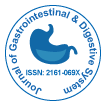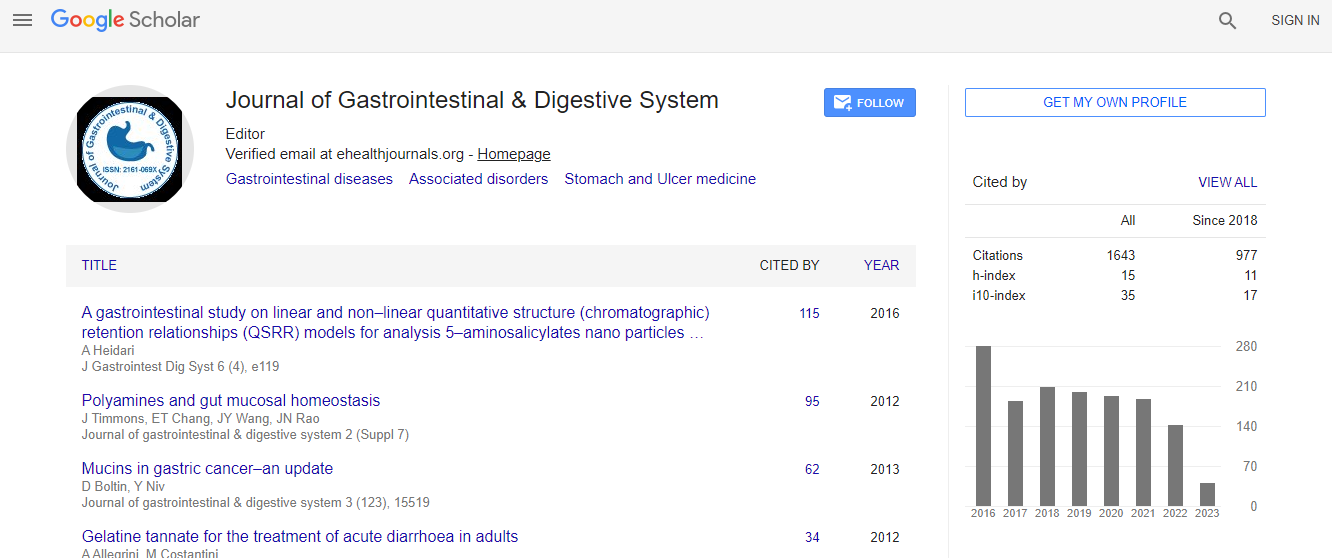Our Group organises 3000+ Global Conferenceseries Events every year across USA, Europe & Asia with support from 1000 more scientific Societies and Publishes 700+ Open Access Journals which contains over 50000 eminent personalities, reputed scientists as editorial board members.
Open Access Journals gaining more Readers and Citations
700 Journals and 15,000,000 Readers Each Journal is getting 25,000+ Readers
Google Scholar citation report
Citations : 2091
Journal of Gastrointestinal & Digestive System received 2091 citations as per Google Scholar report
Journal of Gastrointestinal & Digestive System peer review process verified at publons
Indexed In
- Index Copernicus
- Google Scholar
- Sherpa Romeo
- Open J Gate
- Genamics JournalSeek
- China National Knowledge Infrastructure (CNKI)
- Electronic Journals Library
- RefSeek
- Hamdard University
- EBSCO A-Z
- OCLC- WorldCat
- SWB online catalog
- Virtual Library of Biology (vifabio)
- Publons
- Geneva Foundation for Medical Education and Research
- Euro Pub
- ICMJE
Useful Links
Recommended Journals
Related Subjects
Share This Page
Pediatric gastrointestinal basidiobolomycosis: Case series
International Conference on Pediatric Gastroenterology and Pediatric Practices
Abdulaziz Mohammed Al Dakhil, Alaa Aljuaid, Mohammed Haneef, Moayysar Karami, Walaa Almansory, Hatim Maghrabi, Abdulqader Al Rezqi and Moahmmed Sati
King Saud Bin Abdulaziz University for Health Sciences, KSA
Posters & Accepted Abstracts: J Gastrointest Dig Syst
Abstract
Objectives: Basidiobolusranarum is a fungus known to rarely cause chronic skin and subcutaneous infections and even more rarely it can present as gastrointestinal basidiobolomycosis (GIB). In this case report we describe our experience with GIB in the western region of Saudi Arabia in which we adopted a conservative approach and limited the role of surgery beyond taking the biopsy. We also describe our utilization of voriconazole that seems a promising agent in treating GIB. Methods: Health records of five patients with GIB were retrospectively reviewed. These patients were diagnosed between January 2012 and March 2014 at King Khalid National Guard Hospital in Jeddah, Saudi Arabia. Results: All patients were males from the southwestern region of Saudi Arabia. All of our five cases had leukocytosis, while eosinophilia was significant in four out of five patients. Four cases were managed medically with voriconazole and one case with itraconazole. None of our cases were managed surgically unless complications occurred (two out of five patients). Three cases have shown complete resolution of their symptoms. One patient that required multiple surgeries died later due to surgery complications. Conclusion: The prognosis of GIB in pediatric patients is usually favorable if diagnosed early and aggressive surgery was avoided. To achieve early diagnosis, high index suspicion is required. We suggest fine needle biopsy instead of invasive biopsy to diagnose the disease by histopathology to minimize complications if possible. We also think that Voriconazole is an effective and promising alternative to Itraconazole in treatment of GIB.Biography
Email: aziz.aldukhayil@gmail.com

 Spanish
Spanish  Chinese
Chinese  Russian
Russian  German
German  French
French  Japanese
Japanese  Portuguese
Portuguese  Hindi
Hindi 
